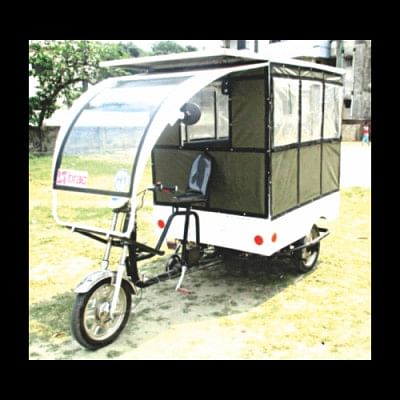Improvised, new look 3-wheelers in the making

A battery-run rickshaw consumes over 960Wh electricity every time it is charged.
And when homegrown low-cost vehicle manufacturer Beevatech Limited pioneered battery operated rickshaws a few years back, the streets in Dhaka were literally swarming with the tricycles, most of which fed on illegal power connections.
Soon, they gained much popularity among the pullers for their new-found speed and elimination of pedalling which requires physical strength.
But as the rickshaws and their brakes were not good enough to maintain the speed (up to 40kmph), the vehicles became accident-prone. So, the government made sure they are off the street.
Five years later, a Brac University initiative, partnering with the same Beevatech, rekindled hope that an array of battery-run three-wheelers can actually hit the roads of Bangladesh and beyond.
With the World Bank finance through the Infrastructure Development Company Limited (IDCOL), Brac University's Control and Applications Research Centre (Carc) has developed prototypes of environment-friendly and cost-effective solar assisted electric tri-wheelers by integrating the innovative torque sensor technology for the first time into the vehicle.
Carc Director and a professor of the university's Electrical and Electronic Engineering (EEE) Department, Prof AKM Abdul Malek Azad led a group of researchers over the past one year, developing the prototype three-wheeler, electrically-assisted human haulier, cargo haulier and ambulance incorporated with PV (photovoltaics) panel and torque sensor pedal.
The vehicles are designed in a way that their pullers would paddle with less effort while torque sensor and solar-powered motors would help gain speed momentum. Wheels and bodies are built in a way to withstand the speed and negotiate with rough patches of roads.
Prof Azad's core research and development team is comprised of project and research engineers Ataur Rahman, Jaber Al Rashid and Sheri Jahan Chowdhury.
Even before the state-run company IDCOL started financing the project from a one million dollar World Bank fund in mid-2015, Carc received a small seed money from the Special Interest Group on Humanitarian Technology (SIGHT) of the Institute of Electrical and Electronics Engineers (IEEE), USA to build the prototype solar-assisted electric rickshaw van for the on-grid and off-grid rural community of Bangladesh.
In its last steering committee meeting, held at New Jersey, USA, the SIGHT team showed interest to visit Carc research facilities at Brac University and take necessary steps to replicate the improvised three-wheelers in Uganda and East Africa. Prof Azad was present there.
IDCOL's Manager for Renewable Energy Mahfuzur Rahman told The Daily Star that they are upbeat about the outcome. "The prototypes developed by Brac University look promising," he said.
Soon, IDCOL is going to arrange a workshop on some solar-based technologies, including the vehicles developed by Brac-Beevatech, to scale up and moot on ways to go for mass production.
Prof Azad told The Daily Star that they have field-tested the vehicles at Genda, Savar and then carried out their necessary re-modifications following performance evaluation and on the basis of feedbacks from rickshaw pullers, passengers, patients, shopkeepers and people of other professions.
He said they have developed three modes of transports for separate purposes -- human hauliers can be used as a convenient mode of transport for providing comfortable experience in the daily movements of rickshaw passengers; ambulance vans with necessary medical equipment for transporting patients from houses to hospitals; and cargo hauliers for carrying goods such as rice bags, medicines, vegetables to different retailing shops in large quantities.
The findings of the field test has showed that the total distance coverage by the help of solar panels and torque sensor pedal technology is around 80-90km a day, three times more than the total distance coverage by the conventional electric rickshaw.
The vehicle can be driven at a speed between 35 and 45 KM/hr.
A solar panel set on the roof would help charge the battery bank whenever the vehicle moves or remains stationary.
One of the most attractive features of the developed vehicle is the application of the innovative torque sensor pedal technology that can reduce the human pedaling effort significantly compared to that of manually driven tri-wheeler.
A total of 72 percent of the available battery storage energy can be saved by the contribution of solar panels and the torque sensor pedal technology. Thus, the use of torque sensor pedal increases the battery lifetime due to less use of the battery compared to that of the battery lifetime of typical electric rickshaws, Prof Azad explained.
The developed human haulier can carry six to eight people at a time whereas the typical electric rickshaw can carry only two to three. Hence, the use of this type of technologically advanced electric tri-wheeler can undeniably increase the income of pullers, causing socio-economic benefits to both on-grid and off-grid rural community, he hoped.
Based on the field test experience, Prof Azad said, all the three types of vehicles were modified using smaller wheels and thicker axle with a total of eight batteries (each 12V, 50Ah) as well as two 500W brushless DC motors to improve the total mileage coverage and mechanical stability of the vehicle, and 400W solar panel for charging the batteries using the solar energy for reducing the impact of overloading the national grid.
To address the safety issues, the modified ambulance vans are also equipped with rear wheel braking system, reverse gear switch, mirror, triple drum brake, shock absorbers, siren, light and shock absorbers both at front wheel and rear wheel, and all the three wheel's base width is widened for better stability during turning in rough surfaces, he added.

 For all latest news, follow The Daily Star's Google News channel.
For all latest news, follow The Daily Star's Google News channel. 



Comments